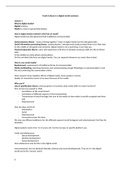Samenvatting
Summary of all the lectures and literature of the course "Youth culture in a digital world"
- Vak
- Instelling
Summary of al 8 lectures and all the articles of the course for 2022/2023 Articles: Gentile, D. A., & Sesma, A. (2003). Developmental approaches to understanding media effects on individuals. Media violence and children, 19-37. Subrahmanyam, K., & Šmahel, D. (2011). Digital youth: The role ...
[Meer zien]



